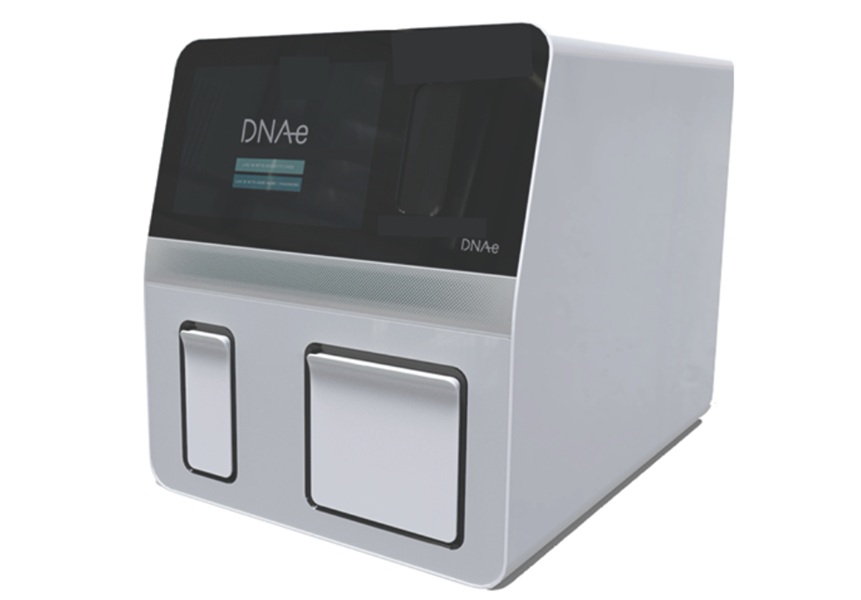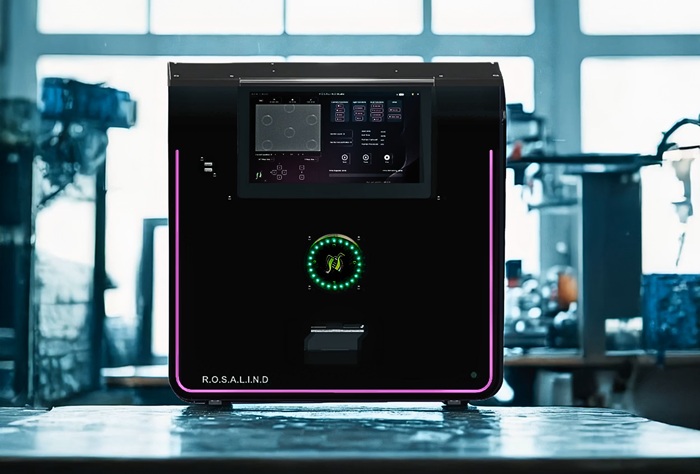COVID-19 Saliva Test Outperforms Commercial Swab Tests
|
By LabMedica International staff writers Posted on 16 Sep 2021 |

Image: Stored in orange-capped vials for mass distribution, the DRUL buffer is part of an inexpensive saliva-based COVID test developed at Rockefeller (Photo courtesy of The Rockefeller University)
A new study has confirmed that a saliva test for COVID-19 performs as well, if not better, than FDA-authorized nasal and oral swab tests.
The “DRUL” saliva test was developed in-house at The Rockefeller University (New York, NY, USA) to identify positive cases within the Rockefeller community. The assay has proven to be easier and safer to administer than the currently available tests, and has been used tens of thousands of times over the past nine months to identify and isolate infected individuals working on the university’s campus.
The DRUL test offered several advantages. It was safe as the test could be taken at home and sent to the lab in a transport medium that kills the virus upon contact. The assay was efficient as it used only off-the-shelf reagents, thus remaining unaffected by shortages that impacted other programs. The DRUL test was also inexpensive at USD 2 per test and was comfortable with the patient providing a sample by simply spitting in a cup.
In a direct head-to-head comparison of 162 individuals who received both Rockefeller’s “DRUL” saliva test and a conventional swab test, DRUL caught all of the cases that the swabs identified as positive - plus four positive cases that the swabs missed entirely. The researchers first assessed DRUL’s limit of detection - how many viral copies the test could catch per volume of fluid. The test succeeded in detecting a single viral particle in one microliter of saliva, a figure comparable to that of the most sensitive assays. The lab then ran 30 nasal swabs that had tested positive for COVID-19 through their novel testing platform and DRUL caught all 30. Next, in a direct challenge, the team compared 162 results from volunteers who received both a swab and a saliva test. Predictably, almost all came back negative. But four that were negative or indeterminate on the swab test were positive on the DRUL assay and, indeed, three of those samples belonged to volunteers who went on to develop symptomatic COVID.
“This research confirms that the test we developed is sensitive and safe,” said Rockefeller’s Robert B. Darnell who developed the in-house assay to identify positive cases within the Rockefeller community. “It is inexpensive, has provided excellent surveillance within the Rockefeller community, and has the potential to improve safety in communities as the pandemic drags on.”
Related Links:
The Rockefeller University
The “DRUL” saliva test was developed in-house at The Rockefeller University (New York, NY, USA) to identify positive cases within the Rockefeller community. The assay has proven to be easier and safer to administer than the currently available tests, and has been used tens of thousands of times over the past nine months to identify and isolate infected individuals working on the university’s campus.
The DRUL test offered several advantages. It was safe as the test could be taken at home and sent to the lab in a transport medium that kills the virus upon contact. The assay was efficient as it used only off-the-shelf reagents, thus remaining unaffected by shortages that impacted other programs. The DRUL test was also inexpensive at USD 2 per test and was comfortable with the patient providing a sample by simply spitting in a cup.
In a direct head-to-head comparison of 162 individuals who received both Rockefeller’s “DRUL” saliva test and a conventional swab test, DRUL caught all of the cases that the swabs identified as positive - plus four positive cases that the swabs missed entirely. The researchers first assessed DRUL’s limit of detection - how many viral copies the test could catch per volume of fluid. The test succeeded in detecting a single viral particle in one microliter of saliva, a figure comparable to that of the most sensitive assays. The lab then ran 30 nasal swabs that had tested positive for COVID-19 through their novel testing platform and DRUL caught all 30. Next, in a direct challenge, the team compared 162 results from volunteers who received both a swab and a saliva test. Predictably, almost all came back negative. But four that were negative or indeterminate on the swab test were positive on the DRUL assay and, indeed, three of those samples belonged to volunteers who went on to develop symptomatic COVID.
“This research confirms that the test we developed is sensitive and safe,” said Rockefeller’s Robert B. Darnell who developed the in-house assay to identify positive cases within the Rockefeller community. “It is inexpensive, has provided excellent surveillance within the Rockefeller community, and has the potential to improve safety in communities as the pandemic drags on.”
Related Links:
The Rockefeller University
Latest COVID-19 News
- New Immunosensor Paves Way to Rapid POC Testing for COVID-19 and Emerging Infectious Diseases
- Long COVID Etiologies Found in Acute Infection Blood Samples
- Novel Device Detects COVID-19 Antibodies in Five Minutes
- CRISPR-Powered COVID-19 Test Detects SARS-CoV-2 in 30 Minutes Using Gene Scissors
- Gut Microbiome Dysbiosis Linked to COVID-19
- Novel SARS CoV-2 Rapid Antigen Test Validated for Diagnostic Accuracy
- New COVID + Flu + R.S.V. Test to Help Prepare for `Tripledemic`
- AI Takes Guesswork Out Of Lateral Flow Testing
- Fastest Ever SARS-CoV-2 Antigen Test Designed for Non-Invasive COVID-19 Testing in Any Setting
- Rapid Antigen Tests Detect Omicron, Delta SARS-CoV-2 Variants
- Health Care Professionals Showed Increased Interest in POC Technologies During Pandemic, Finds Study
- Set Up Reserve Lab Capacity Now for Faster Response to Next Pandemic, Say Researchers
- Blood Test Performed During Initial Infection Predicts Long COVID Risk
- Low-Cost COVID-19 Testing Platform Combines Sensitivity of PCR and Speed of Antigen Tests
- Finger-Prick Blood Test Identifies Immunity to COVID-19
- Quick Test Kit Determines Immunity Against COVID-19 and Its Variants
Channels
Clinical Chemistry
view channel
Noninvasive Blood-Glucose Monitoring Method to Replace Finger Pricks for Diabetics
People with diabetes often need to measure their blood glucose multiple times a day, most commonly through finger-prick blood tests or implanted sensors. These methods can be painful, inconvenient, and... Read more
POC Breath Diagnostic System to Detect Pneumonia-Causing Pathogens
Pseudomonas aeruginosa is a major cause of hospital-acquired and ventilator-associated pneumonia, particularly in lung transplant recipients and patients with structural lung disease. Its ability to form... Read moreMolecular Diagnostics
view channel
World's First NGS-Based Diagnostic Platform Fully Automates Sample-To-Result Process Within Single Device
Rapid point-of-need diagnostics are of critical need, especially in the areas of infectious disease and cancer testing and monitoring. Now, a direct-from-specimen platform that performs genomic analysis... Read more
Rapid Diagnostic Breakthrough Simultaneously Detects Resistance and Virulence in Klebsiella Pneumoniae
Antibiotic resistance is a steadily escalating threat to global healthcare, making common infections harder to treat and increasing the risk of severe complications. One of the most concerning pathogens... Read moreHematology
view channel
MRD Tests Could Predict Survival in Leukemia Patients
Acute myeloid leukemia is an aggressive blood cancer that disrupts normal blood cell production and often relapses even after intensive treatment. Clinicians currently lack early, reliable markers to predict... Read more
Platelet Activity Blood Test in Middle Age Could Identify Early Alzheimer’s Risk
Early detection of Alzheimer’s disease remains one of the biggest unmet needs in neurology, particularly because the biological changes underlying the disorder begin decades before memory symptoms appear.... Read more
Microvesicles Measurement Could Detect Vascular Injury in Sickle Cell Disease Patients
Assessing disease severity in sickle cell disease (SCD) remains challenging, especially when trying to predict hemolysis, vascular injury, and risk of complications such as vaso-occlusive crises.... Read more
ADLM’s New Coagulation Testing Guidance to Improve Care for Patients on Blood Thinners
Direct oral anticoagulants (DOACs) are one of the most common types of blood thinners. Patients take them to prevent a host of complications that could arise from blood clotting, including stroke, deep... Read moreImmunology
view channel
Blood Test Could Identify Colon Cancer Patients to Benefit from NSAIDs
Colon cancer remains a major cause of cancer-related illness, with many patients facing relapse even after surgery and chemotherapy. Up to 40% of people with stage III disease experience recurrence, highlighting... Read moreBlood Test Could Detect Adverse Immunotherapy Effects
Immune checkpoint inhibitors have transformed cancer treatment, but they can also trigger serious immune-related adverse events that damage healthy organs and may become life-threatening if not detected early.... Read moreMicrobiology
view channel
Breakthroughs in Microbial Analysis to Enhance Disease Prediction
Microorganisms shape human health, ecosystems, and the planet’s climate, yet identifying them and understanding how they are related remains a major scientific challenge. Even with modern DNA sequencing,... Read more
Blood-Based Diagnostic Method Could Identify Pediatric LRTIs
Lower-respiratory tract infections (LRTIs) are a leading cause of illness and death worldwide, and pneumonia is the leading infectious cause of death in children under five, claiming the lives of over... Read morePathology
view channel
AI Tool Simultaneously Identifies Genetic Mutations and Disease Type
Interpreting genetic test results remains a major challenge in modern medicine, particularly for rare and complex diseases. While existing tools can indicate whether a genetic mutation is harmful, they... Read more
Rapid Low-Cost Tests Can Prevent Child Deaths from Contaminated Medicinal Syrups
Medicinal syrups contaminated with toxic chemicals have caused the deaths of hundreds of children worldwide, exposing a critical gap in how these products are tested before reaching patients.... Read more
Tumor Signals in Saliva and Blood Enable Non-Invasive Monitoring of Head and Neck Cancer
Head and neck cancers are among the most aggressive malignancies worldwide, with nearly 900,000 new cases diagnosed each year. Monitoring these cancers for recurrence or relapse typically relies on tissue... Read moreTechnology
view channel
Machine Learning Models Diagnose ALS Earlier Through Blood Biomarkers
Amyotrophic lateral sclerosis (ALS) is a rapidly progressive neurodegenerative disease that is notoriously difficult to diagnose in its early stages. Early symptoms often overlap with other neurological... Read more
Artificial Intelligence Model Could Accelerate Rare Disease Diagnosis
Identifying which genetic variants actually cause disease remains one of the biggest challenges in genomic medicine. Each person carries tens of thousands of DNA changes, yet only a few meaningfully alter... Read moreIndustry
view channel
BD and Penn Institute Collaborate to Advance Immunotherapy through Flow Cytometry
BD (Becton, Dickinson and Company, Franklin Lakes, NJ, USA) has entered into a strategic collaboration with the Institute for Immunology and Immune Health (I3H, Philadelphia, PA, USA) at the University... Read more
























